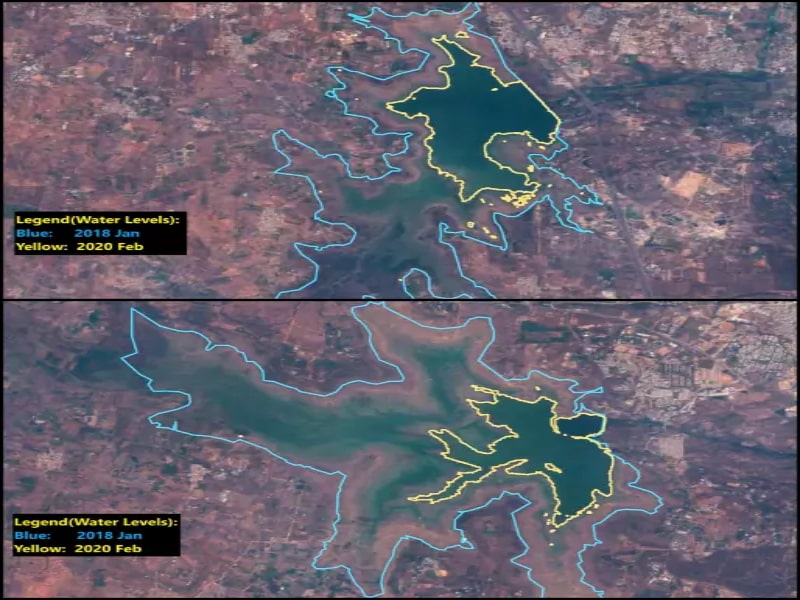Satellite images of Osmansagar, Himayatsagar show summer will be harder in Hyderabad
By Dheeshma
Highlights
- Authorities ridiculed for ‘less rain water’ utterances
- Mismanagement could add to summer worries
Hyderabad: Satellite images of Hyderabad’s twin reservoirs, Osmansagar and Himayatsagar, since 2018 show that this summer will be harder for the people of the city. Though authorities say the situation would not as bad as is being projected because water will be drawn from Krishna and Godavari rivers, the bigger question about the future of the two lifelines of the city continues to haunt.
Satellite images of Osmansagar from the past three years reveal how drastically the inflow into the reservoir has reduced despite heavy rains.
Although, monsoon was bountiful, Hyderabad Metropolitan Water Supply and Sewerage Board (HMSWWB) presently supplies only 24 million litres (ML) of water from Osmansagar and 21 ML from Himayatnagar. This is expected to come down in the coming months.
According to official reports, Osmansagar could supply only 88 million litres (ML) of water last September while it was down to 77 million litres in the very next month. When the capacity of Osmansagar in February of last year was 1.153 TMC, exactly a year later it now stands reduced by 0.037.
While HMSWWB continues to find fault with lack of downpour in catchment areas such as Shankarpally, Chilkur, Vikarabad, Kanapur and Himayatnagar, city environmentalists are blaming rampant encroachment for the deluge.
VL Praveen Kumar, Director Technical, HMWSSB, told NewsMeter that they are utilising only 24ML water from Osmansagar and 21ML from Himayatsagar every day.
“The condition was better last year. Hyderabad received more than normal rainfall. However, it was wayward as only some parts received good rain.”
Meanwhile, he said that there is no need to panic because water would be drawn from Krishna and Godavari rivers in summer.
On the other hand, environmentalists wonder why people have to pay more for water.
Thakur Rajkumar Singh, an environmental activist, who approached the National Green Tribunal in 2016, regarding GO 111 violations, said, “We buy water for Rs seven per litre from Krishna and Godavari. Also since Hyderabad is at a higher altitude the electricity charge associated with pumping water from these two rivers is also high. All these charges are indirectly paid by the tax payer. Investing crores of money, two dams were also constructed. Why can’t the authorities directly pump this water into the two reservoirs? They will not do it because once the reservoirs are full, many encroachments in the area will be gone. In spite of the stay on GO 111, encroachments are still happening in the catchment areas of Osmansagar and Himayatsagar,” Rajkumar said.
“I stay 8 km away from Gandipet. The catchment area of Osmansagar spreads over 15,000 square kilometres. The region has received enough rainfall this monsoon. Therefore, we cannot stand the argument that there is not enough downpour. If we are able to restore all the inlet and outlet channels of both Osmansagar and Himayatsagar, and protect the catchment area we will get sufficient water for two years. One seasonal rainfall is sufficient for two years. Here we are unable to store the free rainwater and use it properly. You don’t need to pump or even purify the rainwater. Instead of ulitizing our natural resources, the authorities are looting the benefits of farmers by pumping water from Krishna and Godavari. “
It is endorsed by Dr C Ramachandraiah, Professor in Urban Studies (CESS), who says, “To accept the government’s claim that there was no sufficient rainfall, we need more profound studies at the ground level. Considering the vast rain, the reservoirs should be full by this time. However, it’s a known fact that the inflow channels that bring water to the twin reservoirs are obstructed or encroached by illegal constructions. Rainwater has to first fill the irrigation tanks in catchment areas and ponds on farms. From here, the fresh inflow happens towards the reservoir. However, today, we don’t have these tanks and ponds to facilitate the fresh-inflow.”
Another activist, Dr Lubna Sarwath, Convener of Save Our Urban Lakes (SOUL) in Hyderabad, said,” Indian meteorological data says that there was 66% excess rainfall in Ranga Reddy district. Right inside Osmansagar, there are constructions, and all the inflow channels have been blocked. They have no intention of restoring those channels and filling the Sagar.”
(Image credits: Pradeep Goud Macharla)